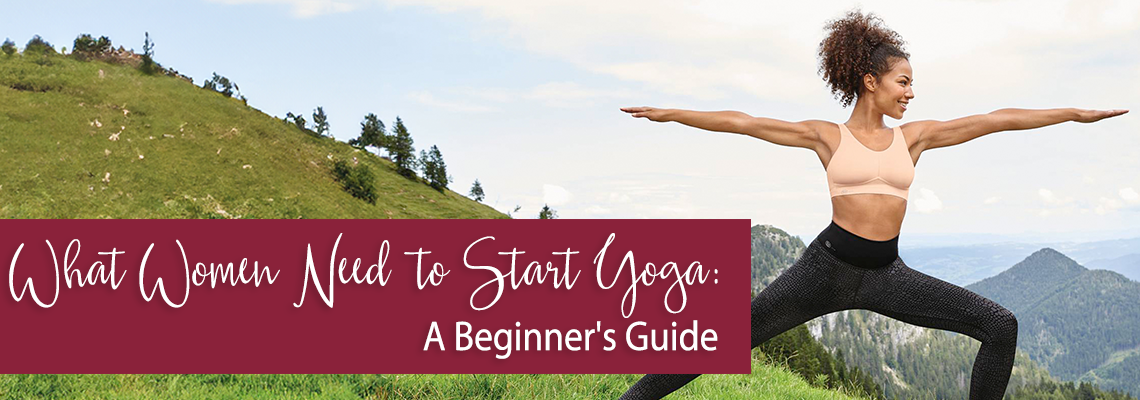What Women Need to Start Yoga: A Beginner's Guide

For the woman who’s looking to improve her flexibility, reduce stress, or just wants a new way to move her body, yoga is a fantastic choice. If you’re new to it, though, you might be wondering where to begin. Some of the questions on your mind might include, “What do I need?”, “What should I wear?”, and “How can I make the most out of my practice?”. This guide for beginners aims to answer all of these questions, and then some:
Understanding the Basics
First-timers might be inclined to think that yoga is just a collection of physical postures, but it’s really much more than that. It’s a holistic practice: one that integrates movement, conscious breathing, and mindful awareness. Yoga also helps with balance, flexibility, strength, and relaxation. While some styles focus on relaxation and deep breathing, others are more dynamic and physically demanding. The key is to start where you feel comfortable and gradually build up from there.
One of the great things about yoga is that you don’t need a ton of equipment or experience to get started. Unlike some other fitness routines that require expensive gear or a gym membership, yoga is incredibly accessible. You can do it at home, in a studio, or even outdoors.
Finding the Right Yoga Style
Before you roll out your mat, it’s helpful to understand the different styles of yoga. Here are a few examples:
- Yin or Hatha yoga might be a good fit for women who are looking for a practice that is slow and meditative.
- Vinyasa or Power yoga is recommended for those who want a more physically engaging practice.
- A gentle flow class may be the ideal choice for women in search of a mix of relaxation and strength.
The best way to figure out what works for you is to try different classes and see what speaks to your preferences. If you’re starting from scratch, consider joining a beginner’s class where instructors guide you through the basic poses and help you with alignment. Many studios offer introductory courses, and there are plenty of online resources to help you ease into your practice from the comfort of your very own living room.
What to Wear to Yoga
When it comes to yoga attire, comfort is key. You’ll want to wear clothing that moves with you and allows you to stretch without restriction.
Leggings or yoga pants paired with a breathable top are the ideal choices. However, avoid wearing anything too loose, as oversized clothing can get in the way when you’re moving into different poses.
Since many yoga classes involve bending and inversions, opt for tops that stay in place rather than riding up. If you tend to get warm easily, choose moisture-wicking fabrics to keep you cool and comfortable throughout your session.
A wireless supportive sports bra is also essential, especially if you plan on doing more active forms of yoga. Here are some of our top recommendations:
- Our FRONTLINE OPEN sports bra fastens at the front (hence the name) to make dressing and undressing fast and easy. It offers firm support.
- Our LIGHT & FIRM wireless supportive sports bra is available in cup sizes A to G and offers firm support, making it the ideal choice for yoga.
- Our PanAlp™️ air sports bra features a distinctively minimalist design and combines ultra lightweight mesh fabric with thoughtful details. It also offers firm support.
- Our PanAlp™️ Delta Top sports bra is made out of breathable tech fabrics and features our patented DeltaPads as well as wide padded straps and sophisticated cups. It also offers firm support.
- Our PanAlp™️ Wool sports bra combines premium merino wool with ultra lightweight mesh fabric. It dries quickly, is breathable, and odor-neutral. It also offers firm support.
Finally, barefoot is the way to go for most yoga styles, as it helps with stability and grip. If you prefer a little extra support, though, you can wear yoga socks with grips on the bottom.
The Must-Have Yoga Essentials
Yoga is an activity that doesn’t need much equipment, but everything you do need to have is important.
A good-quality yoga mat is non-negotiable – a non-slip mat provides stability and cushions your body during poses. While many studios provide mats, having your own is more hygienic and ensures you’re always comfortable with the texture and thickness.
Props like blocks, straps, and bolsters can help you ease into poses and maintain proper alignment. They’re especially useful for beginners, as they offer support and make certain postures more accessible. If you're practicing at home and don’t have yoga props, you can improvise with items like pillows and books.
Hydration is also important, so bring a water bottle, especially if you’re attending a heated or power yoga class. You might not need to sip throughout the session, but having water on hand is always a good idea.
The best part of starting yoga is that there really isn’t a right or wrong way to begin. So long as you’ve got your mat, some comfortable clothes, and an open mind, you’re all set! As you build your practice, you’ll discover what works best for you and how yoga can fit into your life.
Comments:
No Comments
